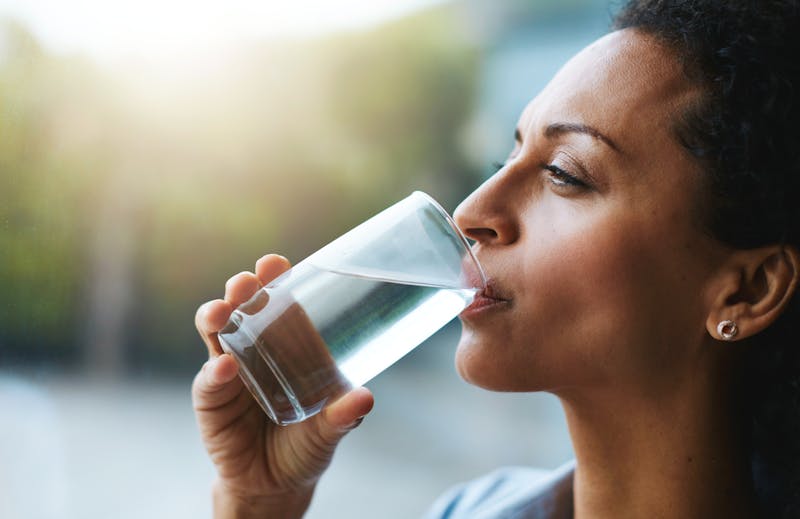
Arizona summers are the best time of the year, but the heat is extreme. The more time you spend outside and the more rigorous the activity, the more important it is to hydrate your body. Increasing your water intake, consuming hydrating foods, and increasing electrolytes reduces your risk for dehydration and heat-related illness. The hydration tips below help you take a proactive approach to dehydration.
Signs you’re dehydrated
- Feeling thirsty
- Dark yellow, strong-smelling urine
- Dehydrated skin
- Dry mouth, lips, or tongue
- Feeling dizzy or lightheaded
- Sunken eyes
- Unexplained fatigue
- Urinating less than every 2 to 3 hours
Hydrating beverages
Be mindful of the sugar content and serving size of non-water beverages.
- Water should be your top source of hydration. This includes sparkling water.
- Unsweetened herbal tea and bone broth provide hydration and nutrients.
- Coconut water and sports drinks provide electrolytes and hydration.
- Milk, bottled juice, freshly squeezed juice, and smoothies are hydrating.
Healthy and refreshing summer beverage
Steep mint tea in cold water for 1 to 2 hours (or overnight) for a cooling and refreshing summer beverage! Drink within 48 hours.
#1 Tailor your water intake
Drinking 64 ounces of water per day is one of the top hydration tips. With water-rich fruits and vegetables, that’s about enough water for the average adult at moderate temperatures and when engaging in moderate physical activity.
Personalize fluid intake with the tips below:
- Drink half of your body weight in water per day. So, if you weigh 150 pounds, aim to drink at least 75 ounces of water per day.
- When it’s hot, humid, or you’ll be sweating heavily, drink an additional 24 to 30 ounces of water per hour.
- Even if you’re extremely thirsty or feeling dehydrated, do not drink more than 48 ounces of water per hour.
- When sweating profusely, drink 1 serving of coconut water or a sports beverage, or add an electrolyte packet to your water.
#2 Drink before you’re thirsty
Thirst is the first sign of mild dehydration. So, the objective is to drink before you feel thirsty. However, expect to wake up thirsty each day. This is because you’ve gone 8 hours or more without water. Drinking 8 to 16 ounces of water first thing in the morning helps restore your hydration levels.
Be mindful that dry mouth can be mistaken for thirst
Dry mouth increases the likelihood of plaque, tooth decay, mouth sores, and other oral health issues.
It’s common for your mouth to be dry first thing in the morning, but it shouldn’t be dry all day long. Prescription medications or drinking too many acidic beverages (including coffee) can cause dry mouth. Consider drinking acidic beverages through a straw.
#3 Use a health app
Hydration is a daily commitment, but it’s easy to get busy and forget to drink enough water. So, leverage technology to remind you, even when you’re indoors or at work.
Configure your smartwatch, health apps, and nutrition apps to remind you to drink water throughout the day. Or set an alarm at intervals throughout the day. This includes tailoring how much water you need daily or when engaging in high-intensity activities.
#4 Bring hydration with you
A top tip for staying hydrated is to bring a water bottle, herbal tea, or sports beverage with you as a reminder to hydrate. Especially if you’ll be somewhere where it’s not fast and easy to buy beverages.
When hiking or outside enjoying your favorite summer activities, bring more hydrating fluids than you think you’ll need. This way, you won’t get dehydrated if you’re outside longer than expected. And you can share if someone else forgets their beverages or doesn’t bring enough.
When hiking, invest in hands-free water bottle straps or wear a small backpack or crossbody bag with a water bottle holder.
#5 Eat hydrating foods
When you plan your meals and snacks for the week ahead, especially when you’ll be active or outdoors, prioritize foods that hydrate. All fruits and vegetables contain hydrating water and electrolytes, but some more than others.
This includes:
- Hot soup, gazpacho, and bone broth.
- Milk, yogurt, and cottage cheese.
- Melons, grapes, citrus, berries, celery, and leafy greens.
#6 Bring electrolytes with you
Electrolytes aren’t just for athletes! Increased electrolyte consumption is a hydrating tip we can all benefit from. If you can’t quench your thirst with water, it’s a sign your body is low on electrolytes.
Electrolytes are essential minerals that you lose in excessive amounts when you sweat. Restoring your electrolyte levels is essential for ensuring the fluids you drink can easily permeate your cells. If you only drink water, your body may not be able to achieve an optimal balance of water inside and outside of your cells.
Any time you sweat, you lose water and electrolytes. This includes sodium, potassium, chloride, calcium, magnesium, phosphate, and bicarbonate. In addition to coconut water and sports drinks, carry electrolyte packets with you in the summer. This allows you to replenish your electrolyte levels if your outdoor plans run longer than expected or if a spontaneous activity arises. Or if it’s an average day, and drinking water doesn’t quench your thirst.
Signs you need more electrolytes
- Insatiable thirst
- Muscle cramps
- Unexplained headache
- Stomachache
#7 Seek or create shade
Even if the weather is humid or 100+, you’ll sweat less in the shade. So, sit in the shade, use a sun umbrella, and wear a hat. In addition to shade, cool off in an outdoor pool or run through the sprinkler. Yes, adults can run through the sprinkler too!
In addition to learning the hydrating tips on this list, take care of your skin when perspiration is heavy or prolonged. Maintain skin health by wearing sweat-wicking and breathable clothing. This includes clothing designed to minimize the need for topical UV protection.
Don’t forget UV protection
And remember, broad-spectrum sunscreen isn’t body lotion. It’s designed to protect, not hydrate. Apply 10 minutes or so after body lotion, ideally 30 minutes before sun exposure. Reapply as directed, typically every 2 hours when in direct sunlight. Use waterproof formulas when sweating, swimming, or enjoying water activities.
#8 Limit dehydrating foods and beverages
Diuretics and high-sodium foods dehydrate. The foods below are diuretics that increase urine production, or they’re high in sodium.
- Alcohol
- Coffee
- Salty snacks
- Prepackaged candy
- Fried foods
- Processed meat
- Processed food
- Many condiments
Isn’t salt an electrolyte?
Yes! Sodium is an electrolyte that you need to replenish when you perspire. However, sodium intake is a delicate balance. When you consume more sodium than your cells require, it draws water out of your body.
Aim for about 2,300 mg of salt per day, spread throughout the day. However, most Americans consume 1,000 mg more salt per day than their body requires. This contributes to dehydration and increases your risk for a range of health conditions.
In most cases, salting the meals you prepare from scratch and adding a bit more salt to homemade meals isn’t the problem. Most excess salt comes from prepackaged snacks and processed foods.
#9 Hydrating skin tips
Don’t forget your skin! When your skin is dehydrated, it’s lacking water in the uppermost layer. However, dehydrated skin typically can’t be resolved with topical moisturizers alone. You’ll need to restore your internal hydration.
Dehydrated skin is a sign that you’re internally dehydrated. It’s often mistaken for head-to-toe dry skin. However, dry skin is a skin type and condition you struggle with year-round. Dehydrated skin is short-term when properly addressed. If your face is the only area of your body that’s dehydrated, you’re likely using a harsh skincare product or have an unaddressed source of skin inflammation.
The combination of hand washing and hand sanitizer increases the risk of dehydrated hands. Restore moisture by applying restorative hand lotion multiple times per day.
Your skin may be dehydrated if:
- It feels itchy, tight, or rough.
- Your under-eyes look sunken.
- Under eye circles are darker than usual.
- Fine lines and wrinkles are more apparent.
Skin hydrating tips when in air conditioning
When you’re out in the heat and humidity, you may prefer lighter daytime moisturizer and makeup. If your home or place of business runs air conditioning all day long, it can dehydrate your skin. Also, your eyes, hair, nails, and nasal passages.
Use these tips to minimize or resolve skin dehydration:
- Add a humidifier to your desk and bedroom.
- Apply barrier cream to your face.
- Use thick facial moisturizers year-round.
- Use body lotion with shea butter or oil.
- Add a few drops of oil to body lotion.
- Use eye drops to keep your eyes moist.
- Apply oil to your fingernails and toenails several days a week.
- Apply a light oil layer to your hair or use air-dry hair products.
- Apply a moisture mask to your hair and skin once a week.
#10 Vitamin supplements and IV therapy
Another option is to use electrolyte supplements, vitamin injections, and IV therapy to accelerate hydration as a proactive or reactive approach to dehydration. These options can amp up hydration before you’re outside for a long period or after to aid in rehydration and recovery.
Stay hydrated and have fun this summer!
Staying hydrated requires a combination of the tips above. If you want to learn more about tailored vitamin supplements, vitamin injections, or meal plans that promote weight loss while hydrating and nourishing your body—schedule an appointment with Valley Medical Weight Loss and Med Spa.
We have locations in Phoenix, Tempe, and Glendale.

